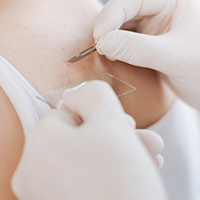
At the Australasian College of Dermatologists, we understand that accessing specialist dermatology care isn’t always easy
What do dermatologists do?
Dermatologists specialise in the diagnosis, treatment and management of all skin diseases and conditions, including skin cancer. In the same way cardiologists are the specialists in heart health, dermatologists are the specialists in skin health.
With skills and expertise spanning medical, surgical and procedural dermatology, specialist dermatologists are at the forefront of skin health research and innovation.
What does the College do?
The Australasian College of Dermatologists (ACD) is Australia’s accredited training body and peak professional and membership organisation for medical specialists in dermatology.
We are the Australian authority in skin, hair and nail health, education, information and advocacy.
We represent 645 Fellows (dermatologists) and 110 trainees.
So why can it be so hard to access the care I need?
Accessing a dermatologist can be difficult. In Australia we have a substantial shortage of specialist dermatologists with only 645 nationwide.
With roughly 2 dermatologists per 100,000 Australians [1], it’s not surprising how hard it can be, particularly for people in regional, rural and remote communities.
Access to specialist dermatology services leads to improved patient outcomes [2] and drives efficiencies within the health system [3].
Ensuring Australia has enough dermatologists in the years ahead will be vital to addressing these access issues.

More outreach services and funding allocated to public hospitals for dermatology services and training will be essential to address these issues in the future.
So, what needs to happen?
To increase the number of dermatologists, we need to increase the number of training places nationally. Registrar training positions are government funded so this requires collaborative effort with federal, state and territory governments to:

Allocate more funding to train and employ more dermatologists in the public system, particularly in regional hospitals where too often there is no dermatologist at all.
Continue to encourage and invest in innovative service delivery models, such as telehealth, to support people to access timely, appropriate and ongoing care.
Enable more outreach services by providing funding to allow dermatologists to travel more frequently to rural and regional areas
What is ACD doing to make this happen?
ACD’s vision is for the highest standard of skin health and dermatology care to be available and accessible to all patients and communities. We want all Australians with skin, hair and nail conditions to be able to access the care they need.
We are actively pursuing innovative models for delivery of specialist dermatology care, interprofessional support and training that can encourage and enable a future generation of dermatologists to pursue careers delivering care and support for currently underserviced communities.
Alongside this, we recognise the invaluable role of GPs in that continuum of care. Our courses, developed and delivered by dermatologists, are supporting GPs and other health practitioners to upskill so that they can respond confidently to the skin health needs of their patients and know at what point a referral for specialist care is needed.
To find out more about our courses for GPs, GP registrars, prevocational doctors and nurses, visit our dedicated education arm, Dermatology Australasia.
We are also working with universities to provide medical students with greater exposure to dermatology as a subject in medical curriculum.
What can I do?
There is a role for each of us to raise awareness of the impact of skin, hair and nail conditions and the need for better access to specialist care.
We at ACD, encourage the general public to get involved and learn more about skin.
Find out more about the impact of skin, hair and nail conditions and the challenges people face by reading our report: More than skin deep: Skin diseases in Australia – navigating the healthcare system
Use your newfound knowledge to educate your family, friends and colleagues on skin conditions and the need to address Australia’s shortage of dermatologists
If you’re someone with a skin condition, don’t suffer alone – talk to your doctor or reach out to a patient support group. Find out more about how to see a dermatologist and find support groups by visiting our new Help, helps resource hub.
Write to your local state and federal MPs and raise awareness of the lack of dermatological services in your region.
Find out more
For more information on our work to improve equity and access to care, read our 2022 White Paper, Accessible and quality dermatology care for all Australians.
References
[1] Figure is based on the current number of practicing fellows of the College and the ABS Population Clock, accessed on November 2023 via: https://www.abs.gov.au/AUSSTATS/abs%40.nsf/Web%2BPages/Population%2BClock?opendocument=&ref=HPKI
[2] Tran H, Chen K, Lim AC, et al., ‘Assessing diagnostic skill in dermatology: A comparison between general practitioners and dermatologists’, Australas J Dermatol. 2005 Nov;46(4):230-4.
[3] Australian Government Department of Health (DoH), Australia’s Future Health Workforce – Dermatology, May 2017, http://www.health.gov.au/internet/main/publishing.nsf/Content/australias-future-health-workforce-dermatology-report, accessed Aug 2018.
